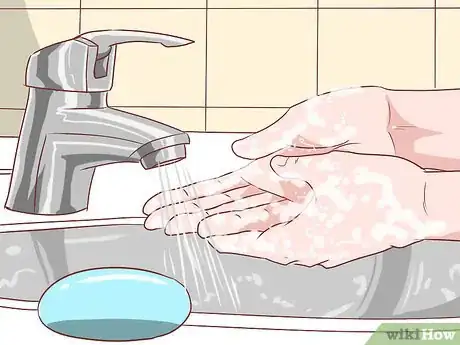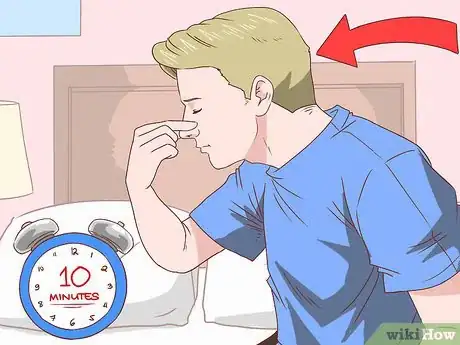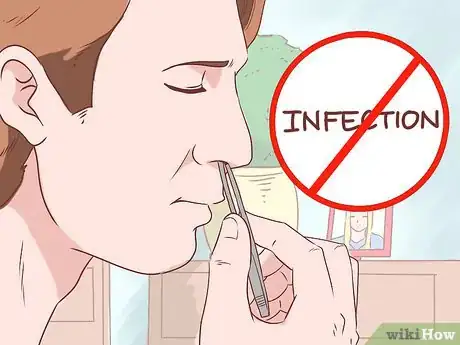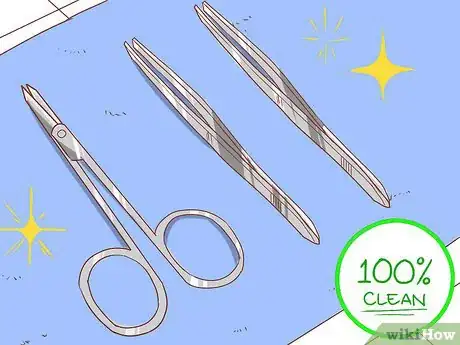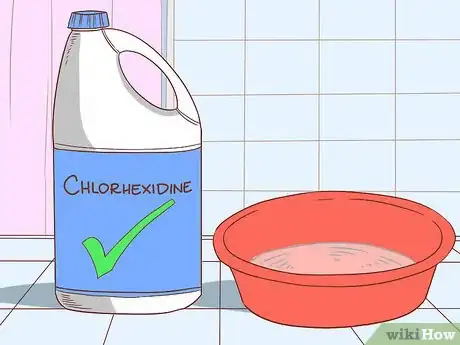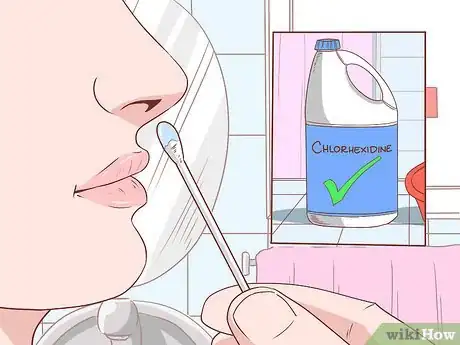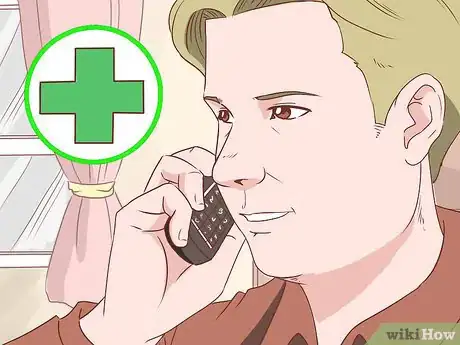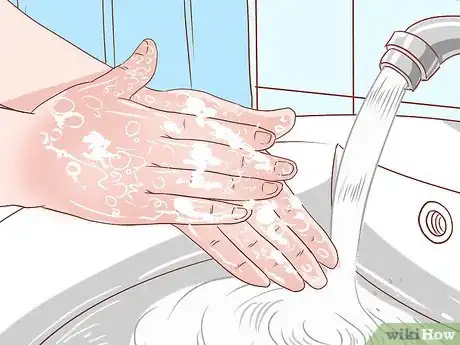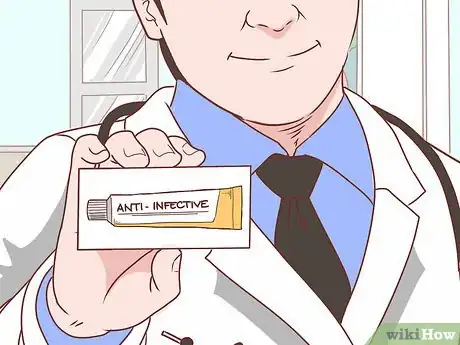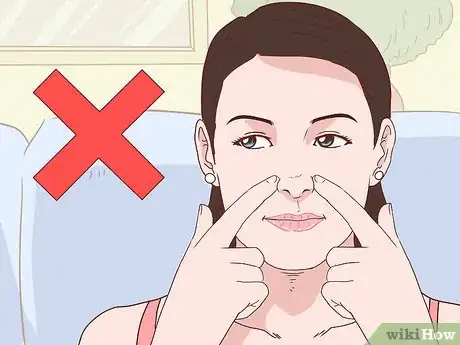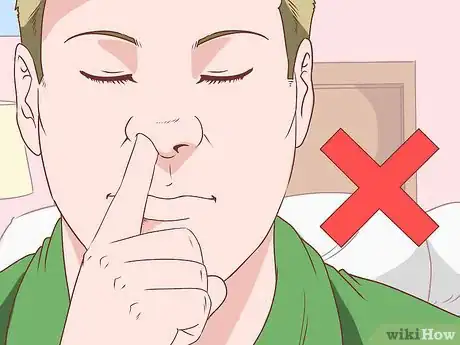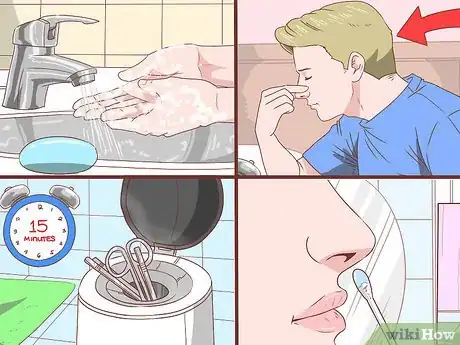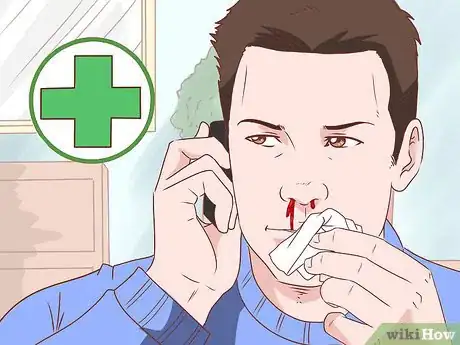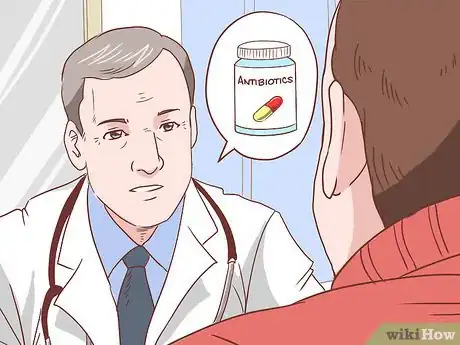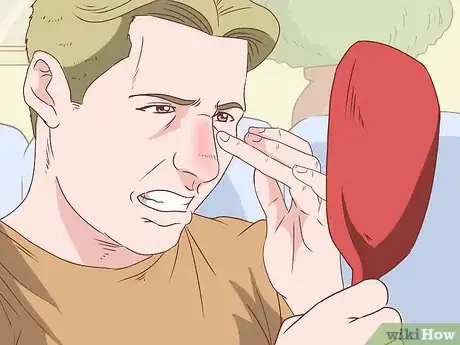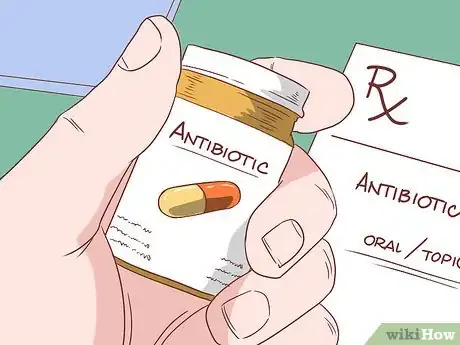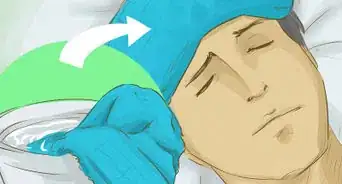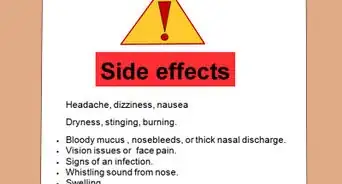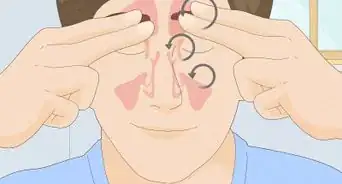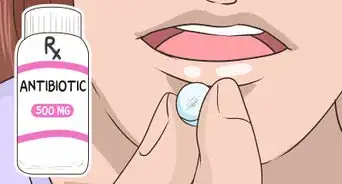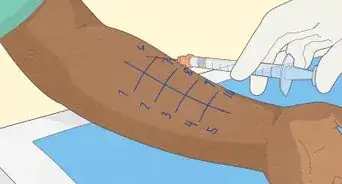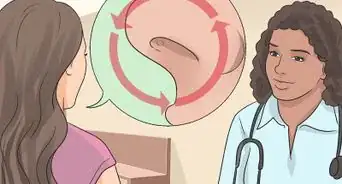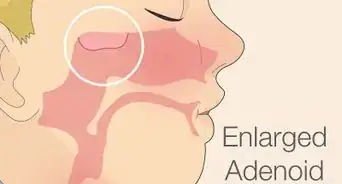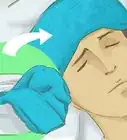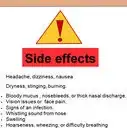This article was medically reviewed by Luba Lee, FNP-BC, MS. Luba Lee, FNP-BC is a Board-Certified Family Nurse Practitioner (FNP) and educator in Tennessee with over a decade of clinical experience. Luba has certifications in Pediatric Advanced Life Support (PALS), Emergency Medicine, Advanced Cardiac Life Support (ACLS), Team Building, and Critical Care Nursing. She received her Master of Science in Nursing (MSN) from the University of Tennessee in 2006.
There are 7 references cited in this article, which can be found at the bottom of the page.
This article has been viewed 751,343 times.
The nose is a sensitive part of the body, so even the smallest cut or sore inside your nose can be complicated to treat, and sometimes painful. Proper care of an injury inside your nose can promote healing and prevent unwanted infections. See a doctor if the bleeding won't stop, the wound won't close up, or you develop an infection.
Steps
Cleaning the Injury
-
1
-
2Stop the bleeding with gentle pressure. If the cut or sore is bleeding and is very near the edge of the nose, then gently apply pressure, using clean materials, until the bleeding stops. Do not block your breathing, and do not pack the nostril. If the injury is not clearly visible or is not right on the edge of your nose, then use the following first aid methods to stop the bleeding:[3]
- Sit up straight and lean forward. Maintaining this position helps to reduce the pressure in the vessels located in your nose and prevents you from swallowing any blood.
- Pinch your nose shut, using your thumb and index finger, and hold it shut for about 10 minutes. Breathe through your mouth during this time. After 10 minutes, release the hold.
- If your nose is still bleeding, then repeat the procedure. If it still bleeds after 20 minutes, seek medical advice, since this might be a sign of a more serious injury.
- Stay cool during this process by wiping your face with a cold cloth or sucking on something cold, like ice chips.[4]
Advertisement -
3Remove any debris from the cut carefully. To reduce infection and possible complications, you can use sterilized tweezers to remove any debris that remains in the cut. Take care not to aggravate the injury or cut yourself with the tweezers.[5]
-
4Use clean tools to clean the area. If you think something is lodged in the area, or if you just need to clean out any skin fragments, tissue, or blood clots, sterilize the items you plan to use. If you are not able to sterilize the tools, make sure they are as clean as possible.[6] To sterilize your tools:
- Wash your hands thoroughly with soap and water.
- Wash any utensils, like tweezers, thoroughly with soap and water, then rinse them completely.
- Place the items in a pot or pan with enough water inside to cover every item.
- Cover the pan with a lid and bring the water to a boil. Continue to boil the water for 15 minutes with the lid in place.
- Remove the pan from the heat, keeping the lid in place, and let it cool to room temperature.
- Drain the water from the pan without touching the sterilized items. If you are not ready to use the items, then leave them in the drained pot or pan with the lid on.
- Carefully remove the items when you are ready to use them. Avoid touching the parts of the tools that will come into contact with the injury. Touch only the handles or grips.
-
5Choose your cleaning agent. Usually, using soap and water is the best way to clean a wound, cut, or minor injury to the skin. In some more delicate and sensitive areas, products that are both cleansers and antibacterial agents are sometimes recommended.
- One common product that is both a soap cleanser and anti-infective is called chlorhexidine. It is available without a prescription in most retail pharmacies. Chlorhexidine should be highly diluted before using on mucous membranes, such as the inside of your nose.
- Read the product labels. Do not use any product that is not approved for use inside the nose.
-
6Clean the tissue around the cut. In order to reach the cut to clean it, you may need to carefully use a cotton swab or a piece of rolled up gauze. Use fresh water and mild soap or a small amount of chlorhexidine on the end of the cotton swab or gauze. Repeat your method with clean, fresh water and clean tools to rinse away any soap residue.[7]
- Use clean or sterilized tweezers to hold the gauze in order to effectively clean the area.
-
7Seek medical help if the area is hard to reach. If you cannot easily see the cut, or reach it, then you may have trouble properly treating the area. You could do additional damage or introduce bacteria if the cut is up inside the nose. Call your doctor or go to an urgent care clinic instead of trying to deal with the cut yourself.[8]
Treating the Cut
-
1Wash your hands before treating the cut. Your cut is an entrance for unwanted bacteria into your bloodstream. Wash your hands with warm, soapy water before handling the area.[9]
-
2Ask your doctor about putting any product in your nose. Anti-infective or antibiotic creams and ointments are made to be used on superficial cuts and scrapes, but may not be appropriate for more severe injuries further up inside your nose. Ask your doctor if this product can be safely used to treat the cut inside your nose. Products like this can be purchased without a prescription at your local pharmacy.[10]
- If your doctor approves, place a small amount of the anti-infective cream or ointment on the end of a cotton swab or on a small piece of gauze. Carefully apply the medicated cream or ointment to the area surrounding the cut.
-
3Avoid touching the cut with your fingers. If you must use your hands to apply treatment, then be sure you have washed them thoroughly.[11]
-
4Do not pick at the area. Once you have applied the medication, leave the area alone. Keep your fingers away, and do not pick at the scab. Picking at the area can prevent the cut from healing and increase your risk of infection.[12]
- Gently cleaning the area and using a moisturizer safe for your nose may help to prevent the formation of large and uncomfortable scabs. Consider using the anti-infective ointment or a small amount of petroleum jelly or Vaseline to keep the area moist.
- This should help the cut to form smaller and softer scabs and help the area to heal on its own.
- Try using Nasya oil drops in your nose at night to soothe the area and promote faster healing. You can get these drops from an Ayurvedic medicine practitioner or a store that sells natural medicines and supplements.
-
5Re-apply the treatment as needed. Depending on the placement of the cut, its length, and its depth, you may need to repeat the application of the medication every day, or every few days. Use caution so as not to introduce any bacteria.[13]
Handling a Severe Case
-
1Seek medical attention if the bleeding does not easily stop. Persistent bleeding can indicate a broken bone, a deep cut inside your nose, or a more severe medical condition. Bleeding that continues for more than 15 to 20 minutes is a warning sign that something more serious may have happened.[14]
-
2See your doctor if the cut does not begin to heal within a few days. Some injuries that occur inside the nostrils may need to be medically treated. The nose is a sensitive area with a lot of blood vessels, fluids (like mucus), and sinus drainage—all of which contain bacteria. Some injuries that occur inside the nose need to be treated by a doctor, or even a specialist, such as an ear, nose, and throat doctor.[15]
- In some cases, the wound may seem to heal properly, but returns in a few weeks or months. This is a sign of a possible infection. You may need to ask a doctor about antibiotics and medical procedures that can prevent your sore from coming back.[16]
-
3Seek medical help if an animal is involved. If your cut was caused by an animal, or by something dirty with ragged and uneven edges, you need to be certain that the area is properly cleaned and treated. The earlier you identify an infection, the easier it will be to safely treat and control.[17]
- See a doctor as soon as possible if your nasal injury was caused by something that could carry the potential for a serious systemic infection.
-
4Watch for signs of infection. Regardless of the cause of the cut, infections warrant prompt medical attention. Heed the following symptoms of infection:[18]
- The area does not improve in a few days or begins to get worse.
- The area begins to swell and feels warm to the touch.
- The wound is causing a thick or pus-like drainage, and you notice an odor coming from the injury or the drainage.
- You start to run a fever.
-
5Ask your doctor about treatments for an infection. In most cases, a physician will write you a prescription for an oral or topical antibiotic. Depending on the treatment, you can expect the cut to heal within a week or two once you have begun an antibiotic regimen.[19]
-
6Talk to your doctor if you have unexplained sores in your nose. If you have sores or wounds in your nose and you’re not sure what’s causing them, make an appointment with your doctor. Nasal sores or nosebleeds can be a symptom of an underlying condition, such as:[20]
- A sinus infection or cold
- Allergies
- A bleeding disorder or excess bleeding caused by certain medications
- A deviated septum
- A more serious infection in the nose, such as MRSA (a type of antibiotic-resistant bacterial infection)
- In rare cases, sores in the nose can be a symptom of a serious medical condition such as nasal cancer, lupus, or HIV/AIDS
Expert Q&A
Did you know you can get expert answers for this article?
Unlock expert answers by supporting wikiHow
-
QuestionHow long is the healing process when my nose was cut from the inside?
 Luba Lee, FNP-BC, MSLuba Lee, FNP-BC is a Board-Certified Family Nurse Practitioner (FNP) and educator in Tennessee with over a decade of clinical experience. Luba has certifications in Pediatric Advanced Life Support (PALS), Emergency Medicine, Advanced Cardiac Life Support (ACLS), Team Building, and Critical Care Nursing. She received her Master of Science in Nursing (MSN) from the University of Tennessee in 2006.
Luba Lee, FNP-BC, MSLuba Lee, FNP-BC is a Board-Certified Family Nurse Practitioner (FNP) and educator in Tennessee with over a decade of clinical experience. Luba has certifications in Pediatric Advanced Life Support (PALS), Emergency Medicine, Advanced Cardiac Life Support (ACLS), Team Building, and Critical Care Nursing. She received her Master of Science in Nursing (MSN) from the University of Tennessee in 2006.
Board-Certified Family Nurse Practitioner
-
QuestionCan I put hydrocortisone on the inside of my nose?
 Luba Lee, FNP-BC, MSLuba Lee, FNP-BC is a Board-Certified Family Nurse Practitioner (FNP) and educator in Tennessee with over a decade of clinical experience. Luba has certifications in Pediatric Advanced Life Support (PALS), Emergency Medicine, Advanced Cardiac Life Support (ACLS), Team Building, and Critical Care Nursing. She received her Master of Science in Nursing (MSN) from the University of Tennessee in 2006.
Luba Lee, FNP-BC, MSLuba Lee, FNP-BC is a Board-Certified Family Nurse Practitioner (FNP) and educator in Tennessee with over a decade of clinical experience. Luba has certifications in Pediatric Advanced Life Support (PALS), Emergency Medicine, Advanced Cardiac Life Support (ACLS), Team Building, and Critical Care Nursing. She received her Master of Science in Nursing (MSN) from the University of Tennessee in 2006.
Board-Certified Family Nurse Practitioner
References
- ↑ http://www.urmc.rochester.edu/encyclopedia/content.aspx?ContentTypeID=90&ContentID=P02804
- ↑ http://www.cdc.gov/handwashing/when-how-handwashing.html
- ↑ http://www.urmc.rochester.edu/encyclopedia/content.aspx?ContentTypeID=90&ContentID=P02804
- ↑ http://www.urmc.rochester.edu/encyclopedia/content.aspx?ContentTypeID=90&ContentID=P02055
- ↑ www.firstaidweb.com/cut.html
- ↑ www.firstaidweb.com/cut.html
- ↑ http://www.urmc.rochester.edu/encyclopedia/content.aspx?ContentTypeID=90&ContentID=P02804
- ↑ www.firstaidweb.com/cut.html
- ↑ http://www.urmc.rochester.edu/encyclopedia/content.aspx?ContentTypeID=90&ContentID=P02804
- ↑ http://www.urmc.rochester.edu/encyclopedia/content.aspx?ContentTypeID=90&ContentID=P02804
- ↑ http://www.urmc.rochester.edu/encyclopedia/content.aspx?ContentTypeID=90&ContentID=P02804
- ↑ http://woundcaresociety.org/heal-cut-inside-nose
- ↑ http://www.urmc.rochester.edu/encyclopedia/content.aspx?ContentTypeID=90&ContentID=P02804
- ↑ http://www.urmc.rochester.edu/encyclopedia/content.aspx?ContentTypeID=90&ContentID=P02804
- ↑ http://woundcaresociety.org/heal-cut-inside-nose
- ↑ http://www.simple-remedies.com/home-remedies/ent-disorder/sores-in-nose-causes-treatment.html
- ↑ http://www.urmc.rochester.edu/encyclopedia/content.aspx?ContentTypeID=90&ContentID=P02804
- ↑ http://www.urmc.rochester.edu/encyclopedia/content.aspx?ContentTypeID=90&ContentID=P02804
- ↑ http://www.urmc.rochester.edu/encyclopedia/content.aspx?ContentTypeID=90&ContentID=P02804
- ↑ https://www.mayoclinic.org/symptoms/nosebleeds/basics/causes/sym-20050914
About This Article
If you need to heal a cut inside your nose, start by washing your hands thoroughly. Next, clean the wounded area with soap and water, or use a cotton swab to apply anti-infective cream or ointment if the cut is in a hard-to-reach area. Then, repeat the process at least once per day to keep the wound clean. Remember to wash your hands each time before you touch the area and avoid picking at the cut to prevent the spread of bacteria. For tips on what to do if the cut won't stop bleeding, read on!
